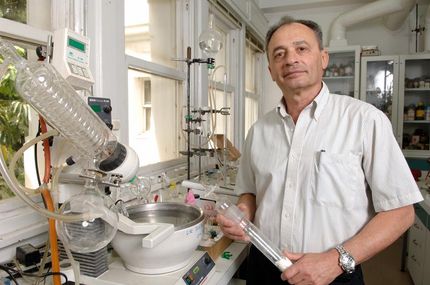Prototype NIST method detects and measures elusive hazards
A chemist at the National Institute of Standards and Technology (NIST) has demonstrated a relatively simple, inexpensive method for detecting and measuring elusive hazards such as concealed explosives and toxins, invisible spoilage in food or pesticides distributed in soil by wind and rain. The prototype method is more sensitive than conventional techniques for detecting traces of these materials, which are polar - like water molecules, having distinct electrically positive and negative ends - and do not readily evaporate.
As described in a new paper, NIST researcher Tom Bruno enhanced a technique called "headspace analysis," which is the detection and analysis of trace levels of chemical compounds from a solid or liquid that are released into the surrounding atmosphere. Bruno's enhancements greatly improve the efficiency of sample collection, for the first time making the technique suitable for detecting low concentrations of polar, low-volatility, compounds such as explosives. Preliminary results indicate the method is sensitive enough to measure amounts of target materials that constitute as little as 0.0000002 percent of a sample.
The sample collection device consists of several coils of fine tubing just 0.32 millimeters in inner diameter. Bruno modified the inner coating, which efficiently attracts and retains chemicals across its large surface area. The device can be used with a sample-heating oven as part of a laboratory analysis system or taken into the field for sample collection. To extract target molecules from a sample, the coil is placed inside an insulated cylinder and chilled with a cold air stream to minus 40 degrees Celsius. A gas, such as helium, is swept across the sample held in the oven or the coil device, gathering up target molecules along the way, and through the fine tubing. Chilling the coils - part of Bruno's innovation - makes collection of target molecules more efficient. The tubing is washed with a solvent, or heated, to release the captured molecules for analysis.
Bruno found that the mass of the collected molecules increases with rising oven and sweep gas temperatures, offering a way to detect specific target molecules under particular field conditions. NIST researchers demonstrated the new method using several explosives, including the pure explosive TNT and the plastic explosive mixture C-4. Among other applications, NIST researchers have used the method to improve sampling and analysis of fire retardants in a car interior, a topic of interest because of concerns expressed by some that the "new car smell" may be a health hazard. They also are using the method to detect volatile protein decomposition products in spoiled meats. Environmental applications could include detection of pesticides deposited on soils subject to weathering effects.
Original publication: T.J. Bruno; "Simple, quantitative headspace analysis by cryoadsorption on a short alumina PLOT column"; Journal of Chromatographic Science 2009, Vol. 47, pp. 569-574, August
Topics
Organizations
Other news from the department science

Get the analytics and lab tech industry in your inbox
By submitting this form you agree that LUMITOS AG will send you the newsletter(s) selected above by email. Your data will not be passed on to third parties. Your data will be stored and processed in accordance with our data protection regulations. LUMITOS may contact you by email for the purpose of advertising or market and opinion surveys. You can revoke your consent at any time without giving reasons to LUMITOS AG, Ernst-Augustin-Str. 2, 12489 Berlin, Germany or by e-mail at revoke@lumitos.com with effect for the future. In addition, each email contains a link to unsubscribe from the corresponding newsletter.
























































